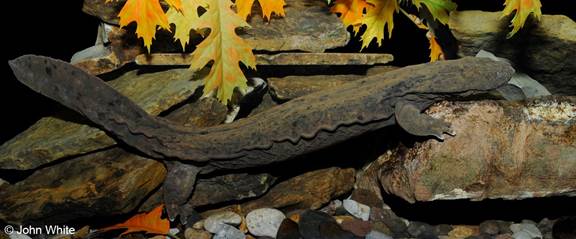Hellbenders are the largest salamander in North America. There are two subspecies -the Allegheny and the Ozark hellbender. Some taxonomists (splitters) believe they are two are separate species, but recent DNA work indicates otherwise.
The Allegheny hellbender is found in a number of Mid-Atlantic/southern states from southern New York to Georgia. The Ozarks subspecies is confined to these mountains of northern Arkansas and southern Missouri. Cryptobranchus from the Greek kryptos (hidden) and branchion (gill). They are the only species in this genus.
This creature is very flat (dorso-ventrally) with thick folds of skin along the sides. It has a single gill slit on each side of the head, hence the genus “hidden-gill”. These animals average around 2 feet long and can grow to 30 inches and have small, dark, beady eyes. Hellbenders can weigh 3.5 to 5 pounds. Given their size and appearance you are not likely to mistake it for anything else. They are known by locals by a number of other names such as devil dog, Allegheny alligator, or mud dog. The one I heard most commonly was snot otter, which kind of says it all.
Hellbenders can live up to 30 years and don’t reproduce until they are 7 years old. A 1996 study in the Susquehanna River watershed indicated that every animal captured was at least 25 years old. Males excavate a breeding chamber beneath a rock or log with its entrance away from the direct current. When a female approaches he will guide or nudge her into the burrow and not let her out until see lays her eggs, which are fertilized outside the body by the male. The females will lay between 1500 – 400 eggs and incubation takes about 45-75 days.
These animals undergo a metamorphosis when they are 1.5 years old when they lose the gills they retained from their larval stage and their toes become more defined on paddle-like feet. Following this transition they can then absorb oxygen through the folds in their skin – which is why they need flowing, oxygenated water.
They have strict habitat requirements for clean, cold, well-oxygenated, swift moving water with large irregularly shaped rocks scattered about. They are reported to be most active just after dark and just before dawn. Hellbenders almost always are found under large rocks during the day. Since they are so flat the can make use of very tight openings.
Their primary prey is crayfish, supplanted by small fish. They secrete a mildly toxic slime in its mouth to reduce friction and it has a powerful jaw. Hellbenders once (sometimes still are) considered ravenous fish eaters and in the early 1900s there was a bounty paid for them in many areas.
I went to graduate school in the western Maryland panhandle squeezed between West Virginia and Pennsylvania and in the Allegheny Mountains. It is great place for field research and prime habitat for hellbenders. The first time I walked into the lab at school I passed by a huge fish tank and in it was this large, prehistoric critter I had never heard about. I almost took them on as my field research subject but went in another direction. Too bad, that project ended up with more funds than my research.
I did work on the project however, and it was always something to be wading through a clear stream, bend over and slowly lift up a rock, wait – and out of the sediment cloud would rise this ugly and lovely amphibian. They can give you quite the bite, but if handled gently they don’t seem to mind so much.
And someone recorded a song about them!! https://www.youtube.com/watch?v=d9uxJZwlwNs
If you ever are in their neighborhood the best hunting are in cool glades of streams with gravel and large, flat rocks. Their populations are dwindling because they reproduce slowly and require relatively pristine conditions. So, if you do get the chance, just be careful with them. They could be quite the senior citizen.
